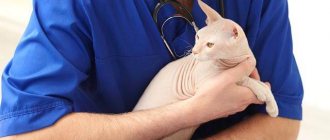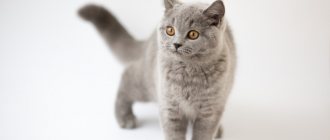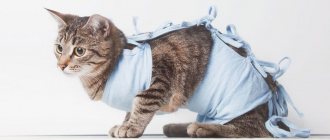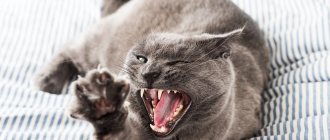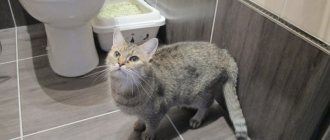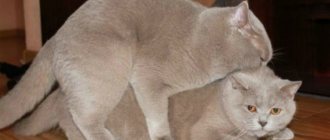For owners of purebred Scots, spaying or neutering their animals is always a difficult choice. For humane reasons, they do not want to inflict pain on their pet; they understand that many years of torture of not satisfying natural needs can affect the physical health of the pet and shorten its life. This is especially true for the castration of the Scottish Fold cat, Scottish Fold, Highland Fold, which have a genetic predisposition to serious diseases of the musculoskeletal system, mating within the breed, which is prohibited.
Veterinary medicine, castration and sterilization technologies have become more gentle and do not harm animals. They, especially cats, return to normal quite quickly after undergoing surgery.
The need for the procedure is also beneficial to the owners themselves:
- Brings relief from the unpleasant odor of urine, which the cat uses to mark its territory during the mating season.
- Saves from periodic, annoying screams and howls of a cat during heat.
When is a Scottish cat neutered?
Veterinarians give clear advice at what age to castrate Scottish kittens - as soon as possible after birth, approximately 10-12 months. This is the optimal age for the operation, when the animal is considered sexually mature, hormones in the body have played a role in development, so there are no contraindications to castration of a Scottish fold cat. The main thing is that the cat is healthy and is examined by a veterinarian.
If a cat is neutered after the experience of mating with a cat, then he may retain the mating process, as well as intuitive memory and behavior.
A Scotsman can and should be castrated at any age, but preferably before the age of 5, when he does not have age-related diseases.
The cost of castration surgery varies depending on the region of the Russian Federation, as well as where it is performed. Calling a veterinarian to your home is convenient for the owner and the cat, but is complicated by special preparations for the site for surgical procedures.
Table No. 1 Approximate cost of castration of cats in different cities of the Russian Federation.
Why do they castrate?
Many people choose a Scottish fold or straight-eared kitten for the soul, because of their love for this breed of cat. Often, breeders themselves neuter pet-class kittens with slight deviations from the standard before sale. This is especially true for Scottish Folds, who are susceptible to genetic diseases due to improper mating.
Unsterilized cats, in the absence of mating, mark the space with stinking urine, during sexual behavior they loudly make terrible sounds and show aggression, which forces the owner to resort to castration surgery.
A conventional operation (orchiectomy), when the testicle in the scrotum needs to be removed, goes quickly. It only takes 15 minutes for the veterinarian to make one small incision, remove the testes, and return the pet to the owner.
Minor complications can arise when you need to castrate, and the kitten is diagnosed with cryptorchidism:
- the ovary-testis is not descended into the scrotum:
- the ovary-testis is located outside the scrotum;
- the ovary-testis is incorrectly located, under the skin in the groin or perineum.
In case of such deviations, the “cryptorchus” operation can be performed in the following ways:
The open method requires surgical intervention with an incision in the place where the ovary-testis is found:
- A more gentle intervention using a puncture, through which the doctor performs all manipulations to remove the ovary and testis.
- Scottish cats should not be fed 5 hours before the operation, because it is performed under anesthesia, and the animal may vomit.
Pet after castration
The entire postoperative period for both straight-eared and fold-eared kittens will last several days and pass without complications. The Scottish cat will need special care on the first day when he recovers from anesthesia:
- be sure to place a sanitary napkin under it; if it is weakened, it may not reach the tray;
- provide a warm place; after surgery, the cat’s internal heat exchange is disrupted;
- Do not place the cat in high places so that it does not fall;
- do not force him to eat, but place him next to a container of water.
After recovering from anesthesia, a well-rested pet will behave as usual. It is important to make sure that he does not lick the incision site. To do this, a postoperative collar is put on him. The wound is treated with an antiseptic for several days.
Why is the procedure needed?
Sterilization and castration are carried out to normalize hormonal levels in those pets whose sexual needs cannot be satisfied naturally. There are two types of indications for surgery: medical and behavioral.
An indication for surgery may be the behavior of the animal:
- the cat constantly marks the territory, after which a pungent smell of urine remains;
- the pet is aggressive, rushes at people;
- During estrus, the cat suffers, screams loudly, and cannot find a place for itself.
If it is not possible to regularly satisfy your pet’s sexual needs, then it is better to undergo surgery. After it, the animal will stop suffering from dissatisfaction and will become much calmer and more affectionate. After castration, cats stop marking, and their urine loses its pungent odor.
Medical indications are primarily related to the fact that hormonal imbalances can lead to many diseases in pets:
- Oncological diseases. Cats may develop cancer of the mammary glands, ovaries and other genital organs. In cats, prostate cancer comes to the fore.
- Pathology of the genitourinary system. This category includes urethritis, prostatitis and other inflammatory and infectious diseases. In addition, it has been scientifically proven that this surgical intervention increases the pet’s life expectancy.
- Stop marking the territory;
- Disappearance of the too strong smell of urine;
- Lack of desire to run away from home;
- Stopping aggressive behavior and maintaining a playful nature;
- Increased life expectancy;
- Prevention of prostatitis, prostate tumors, etc.
- Administration of anesthesia (intravenously, often intramuscularly);
- Preparation of the “operation field”;
- Making two or one small incisions in the skin of the scrotum;
- Ligation of the spermatic cords;
- Removal of testes;
- Treating the stump with antiseptics;
- Administration of standard medications (antibiotic, hemostatic).
The operation does not require stitches and is carried out very quickly. The entire procedure will take 15 minutes.
You can choose the option of castration, when the cat sleeps for 3-4 hours (classic option of castration). At the same time, the cat should not eat on this day, and water can be given only 5 hours after the doctor leaves.
There is a more pleasant option of castration, when the cat comes to his senses already in front of the doctor and even goes to accompany the doctor to the doorstep, controlling his body quite well (which is excluded in the classic version). In this option, you are allowed to eat after 2 hours and drink immediately.
If you wish, you can purchase a cat collar from the doctor, which can be worn for the first 2-3 days to prevent the cat from licking the wound.
Immediately after castration, the food does not change, and the cat eats as before, with its usual food. It is recommended to switch to castrated food 3-4 weeks after neutering. When feeding castrated cats, you should follow a special diet that excludes the consumption of fish dishes.
When are Scottish cats neutered?
Sterilization of Scottish cats: Scottish Folds, Scottish Straights, Highland Folds and Highland Straights is carried out at the moment of puberty, which greatly affects the further development of the animal. It matters whether the age at which the operation is performed is too early or too late. Veterinarians consider the optimal development of a Scottish cat for sterilization to be approximately 10-12 months, this is due to the fact that:
The young pet has already grown up enough, is hormonally mature, is able to withstand surgery without complications, and can easily tolerate anesthesia. It speeds up the healing process of skin tissue, which reduces the possibility of infections.
At a more mature age, up to 5 years, postoperative complications and a poor reaction to anesthesia may occur during sterilization. Long-term healing of postoperative suture.
If the cat has had sexual intercourse, then after surgery and removal of the ovaries, she will not be able to give birth, but will retain the function of producing hormones from the pituitary gland and will continue to reproduce in estrus.
Experienced breeders and veterinarians know that sterilization extends the life of a cat to 4 years, which can be explained by the fact that during frequent births a cat loses strength and health to bear kittens, and does not have enough time to recover.
It is difficult to select a purebred Scottish pair, when the fold-eared ones mate - Scottish Folds, Highland Folds with the straight-eared ones - Highland Straights, Scottish Straights. Mating with individuals of other breeds is prohibited; it leads to the birth of out-of-breed kittens. Unfortunately, they often fall into the category of stray animals. Their number will help to reduce castration and street cats as well.
The cost of sterilizing Scottish cats is much higher in the central cities of the Russian Federation, and the price also increases when calling a veterinarian to perform the operation at home. This is convenient for the owner, but more for the pet:
- Moving is always stressful for an animal;
- At home, she will more easily survive post-operative anesthesia;
- In a weakened state, you cannot catch an infection.
Table No. 2: Approximate cost of sterilization of cats in different cities of the Russian Federation
Why is a cat sterilized?
Despite the severity of abdominal sterilization surgery for a Scottish cat, most veterinarians advise performing a medical procedure during puberty that will free the animal from emotional suffering during estrus. Sterilization is especially necessary for Scottish fold cats: Scottish Fold, Highland Fold, mating, which are prohibited due to genetic abnormalities.
The use of special medications temporarily helps, but does not relieve the cat from repeated heats when the dissatisfied animal accumulates surges of hormones. A constant increased accumulation of them in the organs can lead to serious diseases and shorten the life of the pet.
Abdominal surgery is performed under anesthesia, but the cat’s young body can handle it and in 10-14 days, with proper care, the wound will heal.
The operation itself, which allows you to sterilize a cat, is called ovariotomy, and involves removing the ovaries. A more modern method is castration, or ovariohysterectomy, in which not only the ovaries are removed, but also the uterus itself.
Pet after sterilization
After laparoscopy, which is considered a more modern operation, minimally invasive, low-traumatic, the recovery period is shortened, small wounds, fastened with self-absorbable threads, heal quickly with minor treatment.
It is important to know! Laparoscopy is performed under general anesthesia using surgical procedures; three 2mm incisions are used to sterilize the cat. The doctor inserts a small camera into the abdominal cavity, looking at the monitor screen, and removes the uterus and ovaries.
Minimizing damage
If sterilization is unavoidable, it is necessary to minimize the negative consequences of the operation for the animal. To do this you need:
- Find a good specialist and a reputable clinic where it is possible to monitor the progress of the operation and provide inpatient care for the animal until recovery;
- Choose the time: the optimal age for sterilization of Scottish fold cats is 9-10 months; with an earlier operation, the cat’s body will not complete its formation and developmental deviations may be observed; if it is later, the risks increase in proportion to age;
- Consider post-operative care issues and make an appointment at the veterinary clinic.
READ Treatment of worms in cats: identifying symptoms and prevention
There is no consensus among experts on whether an animal should be bred before sterilization. Some believe that this is correct - if you castrate a cat before the first mating, they will never fully mature. Supporters of early operations argue that after mating, sterilization does not necessarily lead to complete freedom from sexual estrus.
Postoperative care
After the operation in the clinic, the Scottish cat is given to the owner, who is under anesthesia. To provide postoperative care you must:
- transport the animal in a comfortable carrier;
- do not transport an operated cat on public transport, where it can easily pick up an infection;
- at home, allow the pet to freely recover from anesthesia; its duration depends on the drug administered and the cat’s body;
- the cat is placed on the floor, on a warm bedding, which must be changed in time if the cat pees itself;
- If, during the operation, external stitches were placed on the cat’s wounds, then a blanket is put on so that the cat does not reach them with her tongue;
- After the operation, the Scottish woman is not given food. Just put a bowl of water next to it;
- for postoperative constipation, the cat is given a laxative, on the advice of a veterinarian;
- Many people do prescribed intramuscular injections with antibiotics themselves or take their pet to the clinic;
- Wounds are treated with antiseptics twice a day;
- The blanket is removed only after the wounds have completely healed.
Cat food (after surgery)
It is necessary to feed a castrated cat after surgery taking into account his new physiological state, which changes dramatically. He loses interest in cats, and an increased desire for food appears, which is promptly regulated:
- On the first day after the operation, the animal is not fed; it may vomit from the anesthesia; water is placed nearby.
- They think over a diet for natural feeding with an emphasis on protein, fermented milk, ground foods and vegetables.
- With ready-made food, first they give wet food, premium class, designed for neutered cats.
- They feed cats in small portions, do not leave food in bowls, dose the food, and protect the cat from obesity.
- If the kitten is overweight, fasting days are arranged for him.
Cat food (after surgery)
The sterilization operation is difficult for a Scottish cat to tolerate, especially in the first days, until the suture has healed. Subsequently, the cat’s nutrition and behavior will be affected by hormonal imbalances in the body, increased appetite will appear, and metabolism will deteriorate. The owner must follow the rules:
- On the first day after surgery, while the anesthesia is in effect, the cat is not given food. Make sure she drinks water, otherwise dehydration may occur.
- After the operation, to prevent the stitches from coming apart, the castrated cat is fed light pureed food, preventing constipation from occurring.
- Meals should be fractional, in small portions 5-6 times a day, gradually increasing the daily intake to 150 grams.
- A properly formulated diet should contain -35% protein, 35% carbohydrates and 30% fat.
- After the stitches have healed, you can switch to ready-made super-premium food, specially produced for sterilized cats.
- It is necessary to regularly monitor the weight of the Scottish woman; if she deviates from the norm, she is put on a diet.
How does castration affect
You can castrate a Scottish cat without any fears, since the operation, performed by a qualified doctor, does not cause complications and is very easy. After the intervention with the cat, positive changes occur within a month, resulting in the following:
- increased affection;
- great playfulness;
- loss of interest in cats;
- disappearance of the pungent odor of urine;
- stop marking your territory.
If we talk about the negative consequences of castration in Scots cats, then we should highlight the emerging fatness. After removal of the testicles, animals can easily gain excess weight if they are not provided with proper, nutritious nutrition. For this reason, feeding should be coordinated with an experienced physician. You can also refer to the article on feeding Scots.
Vaccinations, vaccination schedule and cost
To protect your Scottish pet from infectious diseases, every owner must follow a vaccination schedule from birth until the end of life. It has been scientifically proven that vaccinated animals have a much lower risk of getting infected.
Based on their composition, vaccines are divided into groups:
- Monovalent, capable of protecting against one infection.
- Polyvalent, designed to protect against several diseases.
According to the effect on the body:
- Inactive, easily transportable with a short duration of action, composed of dead viruses.
- Active bacteria that produce immunity contain live bacteria.
Before vaccinating Scottish kittens, they must be properly prepared:
- 2 weeks before vaccination, Scottish kittens are given prophylaxis against helminthiasis using medications recommended by a veterinarian, the dose of which is calculated based on the pet’s live weight.
- Before vaccination, the animal is switched to a lighter diet;
- Vaccination is strictly prohibited for pregnant cats.
Imported vaccines such as Rabizin and Nobivak Rabies are a vaccine against rabies, and Felovax, Purevax for rhinotracheitis, calicivirosis, panleukopenia, are much better tolerated than domestic drugs. The cost of foreign vaccines is more expensive than those produced in the Russian Federation, but they are more effective and have a guaranteed validity period.
What vaccinations are given to kittens, cost
Small, helpless kittens receive the first antibodies that increase immunity along with the mother's cat's milk. After weaning, instead of colostrum, the baby needs additional protection of the body from viruses and bacteria. At the age of 8-10 weeks, vaccinations are required for Scottish kittens. Before the first vaccinations are carried out, the kitten is prepared and the body is prevented from worms.
Depending on the conditions of detention and lifestyle, the first vaccination for a Scot contains:
- a vaccine against herpesvirus, calicivirus, panleukopenia and rabies, even if the animal leads a permanent home lifestyle;
- They also vaccinate against viral leukemia and chlamydia if the kitten lives in a private house, in a country house and leaves the house where it has likely contact with other animals;
Vaccinations for fold-eared kittens, as well as straight-eared Scots, are performed in accordance with the following scheme:
- At 2 months, the full range of vaccinations with the exception of the rabies vaccine;
- At 3 months, revaccination is carried out with the same complex of drugs with the addition of rabies vaccine.
- Every year and beyond, as the child grows, the entire vaccination package is repeated, including the anti-rabies drug.
The cost of vaccination depends on the price of the drug and factors of the procedure in different regions of the country and consists of:
- from the cost of the most common complex of drugs: Purevax RCPCh + Rabizin + Nobivac Rabies;
- prices for issuing a veterinary passport;
- payment for the work of a veterinarian;
- payment for calling a doctor to your home.
Adults (what vaccinations are given to adults + cost)
Vaccinations for adult cats and Scottish cats have the following advantages:
- they support the immunity of animals to environmental living conditions.
- Vaccinated pets develop a persistent, throughout the year, resistance to serious diseases;
- The vaccinated animal is protected itself and the owner is guaranteed protection, for example, from rabies;
- The occurrence of some infectious processes in a mild form
- When walking in nature and interacting with other animals, the risk of your pet contracting an infection is reduced to a minimum.
Throughout life, the vaccination procedure is repeated annually, preferably in the same month of the year. They make sure that the animal is dewormed on time, is healthy, and that the cat is not pregnant or nursing cubs.
The basic composition and cost are similar to vaccination for kittens, depending on the region and other factors.
Veterinarian tips for caring for your pet
Sterilized cats and neutered cats do not lose, but gain many of the joys of life, and most importantly, their life is extended.
Tip 1 . After the operation, pets are freed from the emotional torment of unsatisfied desires. It is important to remember that the Scottish breed: Scottish Folds, Scottish Straights, Highland Folds and Highland Straights of the pet class are not recommended to be mated either within the breed or with other felines.
Tip 2 . Sterilized cats and female cats have a reduced chance of acquiring urolithiasis, which occurs in many animals due to hormonal surges during “desires” and metabolic disturbances. substances.
Tip 3 . Sterilized animals are prone to overeating; their weight must be constantly monitored. In cases of obesity, switch to a diet.
Essence of the operation
Castration is the complete removal of reproductive organs. When castrating cats, their testicles are removed. This operation is simple and is generally tolerated by animals normally.
Castrating a cat is more difficult - penetration into the abdominal cavity is required. There are several methods of surgery, each with its own advantages. We advise you to choose the one that your doctor knows best.
Sterilization is the partial removal of reproductive organs, practiced in females, and consists of cutting out the ovaries. The uterus remains. Currently, it is recommended to castrate cats too, since the uterus, being unable to function normally in the absence of ovaries, becomes a target for various diseases.

